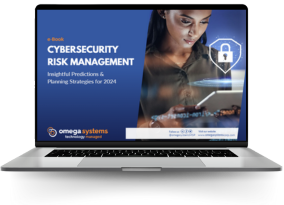

Read our e-book, Cybersecurity Risk Management: Insightful Predictions and Planning Strategies for 2024, for guidance on the essential elements needed to operate as a security-forward organization in 2024 and beyond, including:
Complete the form to access the full e-Book or keep scrolling to read a brief excerpt and learn more about cybersecurity risk management planning for 2024.
Although the vast majority of companies believe they know how to prevent cyberattacks, recent research has shown that this confidence is largely unfounded — in a 2022 survey of consumers and business executives, only 41% of organizations were actively working to mitigate cybersecurity risks. Perhaps unsurprisingly, 57% of participating executives reported experiencing at least one material data breach over the past three years.
With sophisticated attacks on the rise and increasing expectations from clients, insurers, regulators and internal stakeholders, it’s no wonder if you’re struggling with how best to build or enhance your security program.
Our cybersecurity guide explores the importance of effective risk management for businesses of all sizes, across all industries and offers guidance on the essential elements needed to operate as a security-forward organization.
Cybersecurity incidents can be incredibly costly, and they’re increasing at an alarming rate. Data breaches cost companies millions of dollars annually, and experts predict these costs will continue rising over the coming years. As economic fluctuations continue and cybercriminals execute newer, more complex methods of attack, we’re likely to see record numbers of incidents.
Ransomware is one of the most common cyberattacks. It’s a type of malware that encrypts some or all of the victim’s data or device functions until they pay a ransom to the hacker. Typically, the only way to mitigate a ransomware attack is to have a recent data backup ready to launch.
In the second half of 2022, the number of ransomware attacks — and subsequent payouts — actually dropped compared to previous years. This decline in successful attacks is likely occurring because more companies are taking proactive measures to protect their data from disaster, such as:
However, since businesses are better prepared to recover their data in an emergency, hackers are evolving their techniques and turning to more sophisticated tactics to force payouts and gain attention. Some examples include:
Investing in proactive safety measures is essential for protecting your organization against steadily advancing ransomware and malware attacks.
The most prevalent form of social engineering is phishing, which is a type of cyberattack where a malicious actor deceives their victim in an attempt to manipulate them into divulging sensitive information, transferring money or completing other actions.
Phishing attacks increased 61% in 2022 and are likely to become even more common as they diversify into new forms. Some of the newer types of phishing attacks on the rise today include:
Although standard social engineering messages can look very realistic, historically, they have been known to contain several prominent signs that they’re false:
While human writers are prone to making such errors, artificial intelligence (AI) programs like ChatGPT and Google’s Bard are less likely to do the same. Hackers can use these programs to rapidly draft and send more convincing phishing emails, which could increase a company’s likelihood of suffering a breach via social engineering.